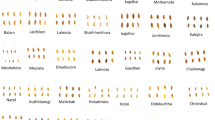Abstract
Agro-morphological characterization of rice is vital for rice breeding programs, which help to document phenotypical differences. The research was conducted in Sundarbazar, Lamjung, during the spring season from February to August 2023, where the design was completely randomized with two replications. Twenty-five quantitative and thirty-nine qualitative traits were recorded according to the characterization descriptors of the International Rice Research Institute, Sixteen quantitative traits were observed for 16 landraces, and 11 showed high coefficient of variance (CV) values. In comparison, for the remaining nine traits, two traits showed a high CV value for all 20 landraces. Three principal components with an eigenvalue greater than one accounted for 88.2% variation. Furthermore, principal component analysis bolsters our results by clustering rice landraces into four clusters. The intra-cluster distance was most significant in cluster I (4.25) and the lowest in cluster IV (2.16), thereby indicating that genotype diversity was the greatest in cluster I and least diverse in cluster IV. Three of the four clusters did not follow geographic distribution, possibly indicating free exchange of landraces among the farmers and adaption of the landraces in both districts. Monomorphism was observed for leaf blade: lemma: anthocyanin in keel and lemma: anthocyanin of the area below apiculus, while high polymorphism was observed for lemma: the colour of apiculus (early observation) (1.542) according to Shannon-Weiner diversity index (H′). Even distribution was observed for traits ligule: colour (0.971), lemma: colour of apiculus: (late observation) (0.920), and sterile lemma: shape (0.908). The Simpson evenness index was maximum for lemma: colour of apiculus (0.783), indicating a higher probability of obtaining two characters for a trait under random selection. Thus, the present study is the preliminary depiction for characterization and diversity analysis in cultivated rice landraces with potential for further rice improvement programs.





Similar content being viewed by others
References
Ahmadikhah A, Nasrollanejad S, Alishah O (2008) Quantitative studies for investing variation and its effect on heterosis of rice. Int J Plant Product 2:297–308
Bajracharya J, Rana RB, Gauchan D, Sthapit BR, Jarvis DI, Witcombe JR (2010) Rice landrace diversity in Nepal. Socio-economic and ecological factors determining rice landrace diversity in three agro-ecozones of Nepal based on farm surveys. Genet Resour Crop Evolut 57(7):1013–1022. https://doi.org/10.1007/s10722-010-9544-x
Bioversity International, IRRI, & WARDA (2007) Descriptors for wild and cultivated Rice (Oryza spp.). www.earthprint.com
Chakravorty A, Ghosh PD (2013) Characterization of landraces of rice from Eastern India. Plant Genet Resour 26(1). https://www.researchgate.net/publication/298344253
Chaudhary P, Gauchan D, Rana RB, Sthapit BR, Jarvis DI (2004) Potential loss of rice landraces from a Terai community in Nepal: a case study from Kachorwa, Bara. Plant Genet Resour Newsl 137:14–21
Das S, Ghosh A (2011) Characterization of rice germplasm of West Bengal. www.pdffactory.com
Ghimire KH, Bhattarai M, Joshi BK, Bhatta MR (2013) Agro-morphological characterization of Nepalese rice (Oryza sativa) L. Landraces. NARC E-Library.
Hasan MJ, Rasul MG, Mian MAK, Hasanuzzaman M, Chowdhury MMH (2000) Genetic divergence of yam. Bangladesh J Plant Breed Genet 7–11
Joshi BK (2017) Conservation and utilization of agro-biodiversity. https://www.researchgate.net/publication/318316609
Joshi BK, Ghimire K, Paudel, MN (2016), Conservation options, methods and programs for Agricultural Plant Genetic Resources in Nepal. https://www.researchgate.net/publication/321300485
Kandel B, Shrestha J (2018) Characterization of rice (Oryza sativa L.) germplasm in Nepal: a mini review. Farming Manag. https://doi.org/10.31830/2456-8724.2018.0002.22
MoALD (2017) A historical, socio-cultural and technical compendium. Crop Development Directorate
Rahman MM, Rasul MG, Bashar MK, Syed MA, Islam MR (2011) Parent selection for transplanted aman rice breeding by morphological physiological and molecular diversity analysis. Libyan Agric Res Center J Int 2:22–26
Shanmugam AS, Sree Rangasamy SR (1982) Genetic diversity for quantitative characters in green gram (Vigna radiata (L.) Wilczek). Madras Agric J 69(10):631–636
Singh A, Singh AK, Singh PK (2014) Characterization and assessment of variability in upland rice collections Identification of QTL (s) for sodicity tolerance in RIL population derived through biparental mating in rice. View project New-frontiers-in-stress-management-for-durable-agriculture View project. https://www.researchgate.net/publication/286451773
Sivakumar P, Chitra M, Gatta VV, Harshavardini K, AVelayutham KV (2021) Exploration of traditional rice (Oryza sativa L.) land races: scope for the future sustainable food production. Pharma Innov 10(10):1039–1043
Zafar N, Aziz S, Masood S (2004) Phenotypic divergence for agro-morphological traits among landrace genotypes of rice (Oryza sativa L.) from Pakistan. Int J Agric Biol 6(2):335–339
Acknowledgements
Authors express heartfelt appreciation to Ghanpokhara and Purkot Community Seed Bank for the invaluable seeds of rice landraces, which were the cornerstone of this study.
Funding
The authors have not disclosed any funding.
Author information
Authors and Affiliations
Contributions
PS experimented and wrote the main manuscript MD. RK and PS were co-researchers BPK supervised research and wrote the manuscript AP supervised reserch.
Corresponding author
Ethics declarations
Conflict of interest
All authors declare that they have no conflict of interest.
Additional information
Publisher's Note
Springer Nature remains neutral with regard to jurisdictional claims in published maps and institutional affiliations.
Appendices
Appendix 1: Score plot of 20 rice landraces for the first and second principal components

Appendix 2: Twenty rice landraces seed and caryopsis variation

Rights and permissions
Springer Nature or its licensor (e.g. a society or other partner) holds exclusive rights to this article under a publishing agreement with the author(s) or other rightsholder(s); author self-archiving of the accepted manuscript version of this article is solely governed by the terms of such publishing agreement and applicable law.
About this article
Cite this article
Shrestha, P., Kandel, B.P., Shrestha, P. et al. Characterization of rice landraces of Lamjung and Tanahun districts. Genet Resour Crop Evol (2024). https://doi.org/10.1007/s10722-024-01929-0
Received:
Accepted:
Published:
DOI: https://doi.org/10.1007/s10722-024-01929-0




